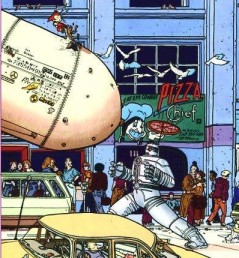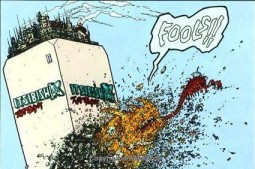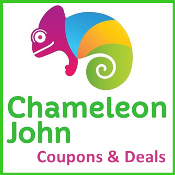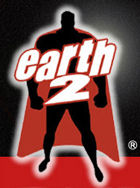| Big
Guy and Rusty the Boy Robot
There
was a time, back before Busiek’s Conan and
the acquirement of the publishing rights to Star Wars
and many Japanese comics, when Dark Horse was a place where
you would find some of the most odd combinations of talent
and concept that ever appeared in comics. Stan Sakai’s
samurai rabbit Usagi Yojimbo and Paul Chadwick’s
classic Concrete are some fine examples of Dark
Horse’s penchant for publishing the strange and wonderful
of our comic book industry.
But
one rather obscure title from Dark Horse’s early days
have been one that I have always been on the lookout for,
and which I have finally found, is Frank Miller’s
and Geof Darrow’s Big Guy and Rusty the Boy Robot.
Japan,
after playing just a tiny bit of God, is under attack from
some malevolent force in the form of a giant lizard, but
it doesn’t have the tender disposition of Godzilla.
This beast has it in mind to destroy humanity and wipe its
stench from the planet by converting all human genetic matter
into replicates of itself. When all conventional methods
are exhausted, Japan sends in its prototype military breakthrough,
a small red headed robot named Rusty. When even Rusty fails
to cull the threat, Japan calls in its last hope: the US-made
Big Guy, a colossal metal warrior who may be the planet’s
last possible hope.
Some
may remember the brief but entertaining Big Guy and
Rusty cartoon that ran on Fox Kids a few years back,
and I’m sure even more remember the teaming of these
two artists on the super-violence pastiche of Hard Boiled,
so one might expect the comic version of these two metallic
monster fighters to be something of a middle ground between
those two works. In many ways it is; the artwork Darrow
produces here is more grotesque and far more graphic than
that of the television animators, but the dialogue, as written
by Frank “Sin City” Miller, remains
much the same as the television show designed for children.
It’s tame, subtly ironic, and only slightly mocking
of the “Giant Monster Attacks City” genre that
it tends to work both as a parody of films like Godzilla
and King Kong and as a decent adventure story.
The
design by Darrow is what is the most impressive and is far
more representative of complex issues than Miller’s
somewhat simple plot and storytelling. Darrow is one of
those rare artists that can draw breathtaking full page
landscapes, as well as technical precision and facial detail,
and make all of them work in the same panel. The grotesque
nature of the monster juxtaposes nicely against the clean,
straight lines of the city of Tokyo. It highlights the struggle
that Miller is beating to death in his monster dialogue:
that of nature versus technological power.
 |
Darrow's
designs for Rusty and Big Guy are also telling and representative
of more than just robots. Rusty’s design, which makes
him appear as a large-headed child with an air foil on his
head, is reminiscent Osamu Tezuka’s Astro Boy. This
is obviously intentional on Darrow’s part, if for
no other reason to demonstrate the difference between a
Japanese and an American design for a robot. Astro Boy
(or Tetsuo Atom for purists) was one of Tezuka’s
earliest works, and it became common after that seminal
work for robots to be depicted in manga as somewhat humanoid.
This became something of a tradition in manga, and it is
very different when compared to the American robot. The
picture of an American robot is historically drawn form
the pulp science fiction tradition, where they were odd
combinations of wires and dials and gears. Our robots, for
whatever reason, appear more mechanical than Japanese robots.
Darrow’s
design of Big Guy highlights these differences well. The
Big Guy has no mouth, square “eyes,” and is
colored white with blue metallic piping all along his chassis.
He looks like a pulp fiction robot. In drawing these characters
in this manner, Darrow seems to be trying to comment on
the differences between our two disparate societies, and
he brings up some intriguing points with his art. The Japanese,
who have made leaps and bounds ahead of the US in terms
of technological development, dream of robots designed to
appear more human. Honda’s Asimo is a fine example;
watch it kick a soccer ball or dance like a person. The
Big Guy is designed to look like a machine or maybe a suit
of armor. Darrow implies that American robots are meant
to be machines and just machines; that to make them more
human in function or appearance might weaken them.
But
one revelation that occurs later in the book leads us to
question if humanity is a negative or positive factor in
this big monster tussle. Because Rusty, the human robot,
cannot defeat the monster, but the Big Guy can stand against
it, raises all manner of questions as to what truly can
confront the onslaught of nature, in this case a giant multi-armed
lizard that can breathe fire, better.
I’m
impressed that I actually got this much deeper meaning from
a story about two robots beating the hell out of a more
talkative version of Godzilla, but Darrow’s artwork
takes the reader to several very interesting places. Unfortunately,
Miller’s writing doesn’t really live up to it.
Miller has done great things (Dark Knight Returns, Sin
City) and some awful garbage (DK2), and this
is not his worst piece. In fact, much of what he writes
is very good, especially the satirical, All-American dialogue
of the Big Guy. However, he forgot to complete the story.
 |
Miller
takes the time to introduce his characters, but really gives
nothing to define them. This is not horrible, as it seems
clear to me that he is striving to lampoon some of the funnier
aspects of the “Big Monster Attacks” genre;
it even works well to eliminate Rusty, the least interesting
character early on, but problems arise here. Miller leaves
the reader with the fight to focus on, which would be fine
if he had managed to add more of an actual fight. Both narrative
boxes and the over-the-top ramblings of the monster in question,
as well as the unnecessary dialogue of those affected by
the monster’s replication process obscure the scenes
of battle.
Almost
all this extra wordiness detracts from Darrow's artwork
by covering it up, and adding very little to the story.
The amount of unnecessary exposition makes the story feel
slower. If the action is all there is to focus on, something
that is not all together bad, than the action has to take
center stage and not be made murky by superfluous verbosity.
Issues of Warren Ellis’s Global Frequency
did this expertly. Miller did not do it here.
All
in all, Miller’s lackluster writing does not help
this book, but Geof Darrow’s artwork alone is worth
the cover price of $14.95. In addition, Dark Horse publishes
this trade in an oversized format (about 9’x 12 ½
‘) so Darrow’s art is on fine display. There
is also a cover gallery from other issues, or what might
be mocked up issues, in the back along with two splash pages
of the Big Guy and Rusty battling monsters alongside the
likes of Spawn and Ash, for some reason. The story is barely
there, but enjoyable, and the art is top notch. Plus, where
else will you find a story about robots, monsters, and societal
concepts of technology? Other than on Robot Wars,
I mean.
Big Guy and Rusty the Boy Robot
|








